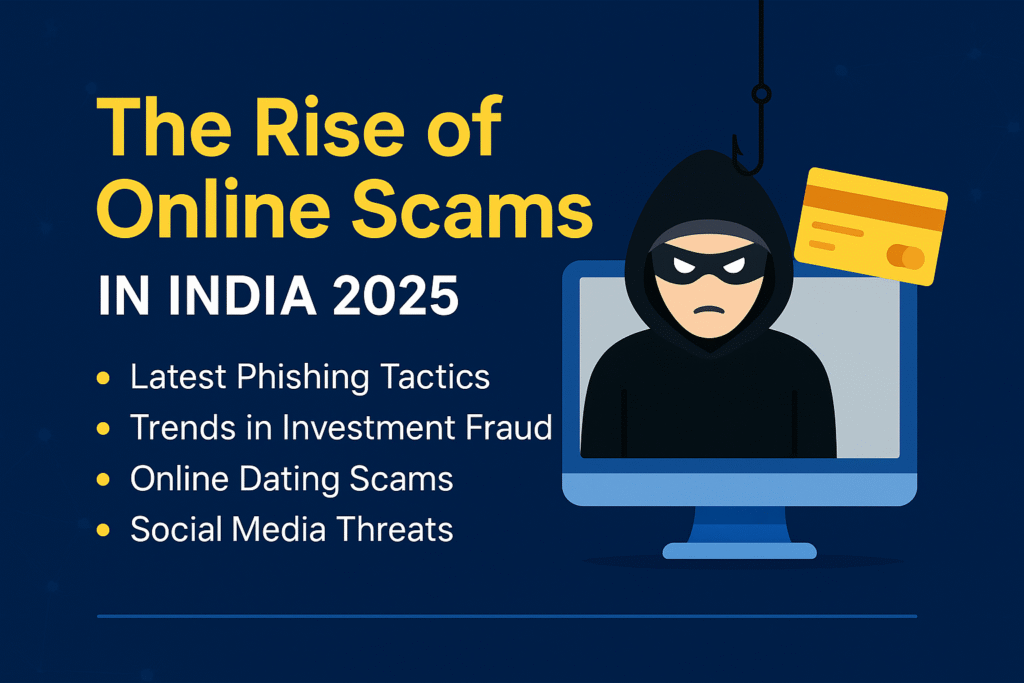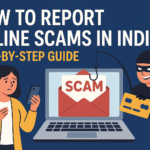📌 Introduction
In the fast-changing digital landscape of India, being aware of emerging threats is more important than ever. Our guide to the Top 10 Online Scams in India 2025 is designed to help you stay one step ahead of cyber frauds and protect your personal information. From rising cases of UPI scams and WhatsApp scams to fake job offers and phishing attacks, this blog covers the most widespread dangers threatening users in 2025. With detailed real-life examples and digital safety tips, this guide will empower you to recognize, avoid, and report online scams in India 2025 effectively, safeguarding yourself and your loved ones from cybercriminals.
🕵️♂️ 1. UPI Payment Scams
Scam Technique: Fraudsters act as buyers or sellers and share QR codes for “receiving” payments. But when victims scan these codes, they unknowingly send money from their accounts. These scams often appear on online platforms like OLX or Facebook Marketplace.
Real Story: Ravi listed a sofa on OLX. A scammer pretending to be a buyer offered to pay through UPI. He sent Ravi a QR code, claiming it would help complete the payment. Ravi scanned it and entered his UPI PIN. Instantly, ₹25,000 left his account.
Why it works: Many users don’t know that QR codes can also send payments. Scammers take advantage of this confusion.
How to Avoid:
- Don’t scan QR codes to receive money. UPI apps like Google Pay and PhonePe never require this.
- Use the “collect request” feature to request payments securely.
- Verify the UPI ID before proceeding.
- If something feels wrong, cancel the transaction and confirm with the other party.
💼 2. Fake Job Offer Scams
Scam Technique: Fraudsters pretend to be recruiters or HR staff. They reach out via email, WhatsApp, or job portals and offer fake job roles. Victims are asked to pay for registration or document verification.
Example: Priya got a WhatsApp message about a government clerk job. The sender said she was shortlisted and asked for ₹2,000 for verification. Once she paid, no one responded.
Why it works: Job seekers are hopeful and may not question offers that look official.
How to Avoid:
- Always verify offers on the company’s career page.
- Don’t pay for interviews or processing.
- Avoid recruiters who insist on using only WhatsApp.
- Check for poor grammar or suspicious email domains.
🏦 3. Bank KYC Update Scams
Scam Technique: Victims receive messages warning them that their bank account will be frozen unless they update their KYC immediately. The link in the message leads to a fake site that captures banking credentials.
Why it works: The urgency causes panic. People act quickly to avoid account suspension.
How to Avoid:
- Your bank will never send KYC update links via SMS.
- Don’t click links from unknown messages. Visit the official bank site.
- Call your bank using the number on your card.
- Report scam messages to 1909.
📱 4. WhatsApp Scam
Scam Technique: Hackers message you pretending to be friends or family. They ask for a 6-digit code sent to your phone. Once shared, the hacker gains control of your WhatsApp.
Why it works: Victims trust the person messaging them.
How to Avoid:
- Never share a WhatsApp code with anyone.
- Enable two-step verification.
- Inform contacts immediately if your account is compromised.
- Use strong security settings on your phone.
🌐 5. Crypto/Investment Scams
Scam Technique: Fraudsters promote fake investment schemes, especially in cryptocurrency. They use social media to promise huge profits. Once you invest, they vanish.
Example: Akshay joined a Telegram group offering crypto tips. He invested ₹50,000 with hopes of 3x returns. A week later, the group was gone.
Why it works: People fall for quick profits without research.
How to Avoid:
- Don’t invest based on DMs or group chats.
- Use only SEBI- or RBI-regulated platforms.
- Research before sending money or crypto.
🛒 6. Fake Shopping Websites
Scam Technique: Scammers build fake e-commerce websites with flashy discounts. They run ads on Facebook or Instagram. Victims pay but either receive fake goods or nothing.
Example: Neha saw a brand-new iPhone listed for ₹6,000. The site had a countdown timer and promised fast delivery. She paid and got scammed.
Why it works: Scam sites copy trusted platforms. Urgent deals push buyers to act fast.
How to Avoid:
- Check website reviews.
- Avoid domains like .xyz or .top.
- Prefer cash-on-delivery if available.
🎮 7. Gaming Recharge Scams
Scam Technique: Fake apps and websites promise free or cheap in-game currency. They ask for login or UPI info. Victims lose access or money.
Example: Raj entered his Free Fire login to get free diamonds. Hours later, he was locked out, and money was missing.
Why it works: Kids and teens are easily tempted by rewards.
How to Avoid:
- Only use official app stores.
- Educate kids about online fraud.
📞 8. Fake Customer Care Numbers
Scam Technique: Victims search for help online and call fake customer care numbers. Scammers ask for remote access or banking details.
Example: Sunita installed AnyDesk as told. The fraudster used it to steal ₹15,000.
Why it works: People trust online search results.
How to Avoid:
- Use only official websites for help.
- Don’t share OTPs or install screen-sharing apps.
🎁 9. Free Gift/Prize Scams
Scam Technique: Victims get messages claiming they have won a car or a mobile. They’re asked to pay a small fee or share Aadhaar info. These details are misused.
Example: Meena paid ₹1,499 to claim a “prize.” She got nothing. Her ID was later misused.
Why it works: Excitement makes people overlook red flags.
How to Avoid:
- Don’t trust prizes you didn’t apply for.
- Never pay to win.
📧 10. Government Phishing Emails
Scam Technique: Emails pretend to be from the Income Tax or UIDAI. They ask for login info or redirect you to fake pages.
Example: Arjun submitted net banking details to claim a fake tax refund. ₹40,000 was gone.
Why it works: The emails look official.
How to Avoid:
- Only trust .gov.in domains.
- Visit official portals for tax or Aadhaar updates.
✅ Conclusion
Online fraud is rising, but awareness is power. By learning about these scams, you protect yourself and others. Always stay alert.
🛡️ Safety Checklist:
- Don’t share OTPs or passwords.
- Avoid unknown links.
- Use official apps and sources.
- Teach your family about cyber safety.
- Report scams at cybercrime.gov.in or call 1930.
🔗 Useful Resources for Safety
- 📱 Cybercrime Helpline: 1930
- 🌐 Cybercrime Portal: www.cybercrime.gov.in
- 📘 Free Cyber Safety Guide: Coming Soon
- 🔁 Share This Post to Spread Awareness
What to Do If You’re Scammed?
Online fraud can be scary, but acting quickly increases your chances of recovering your money and catching the scammers.
👉 Learn how to file an official complaint step-by-step in our latest guide:
How to Report Online Scams in India: Step-by-Step Guide (2025)




Pingback: How to Report Online Scams in India (2025 Guide) – Step-by-Step Instructions
Pingback: How to Secure Your UPI Transactions: 2025 Safety Checklist - Buddha Computers
Pingback: Top 10 Free Tools to Check If You’re Hacked (2025)